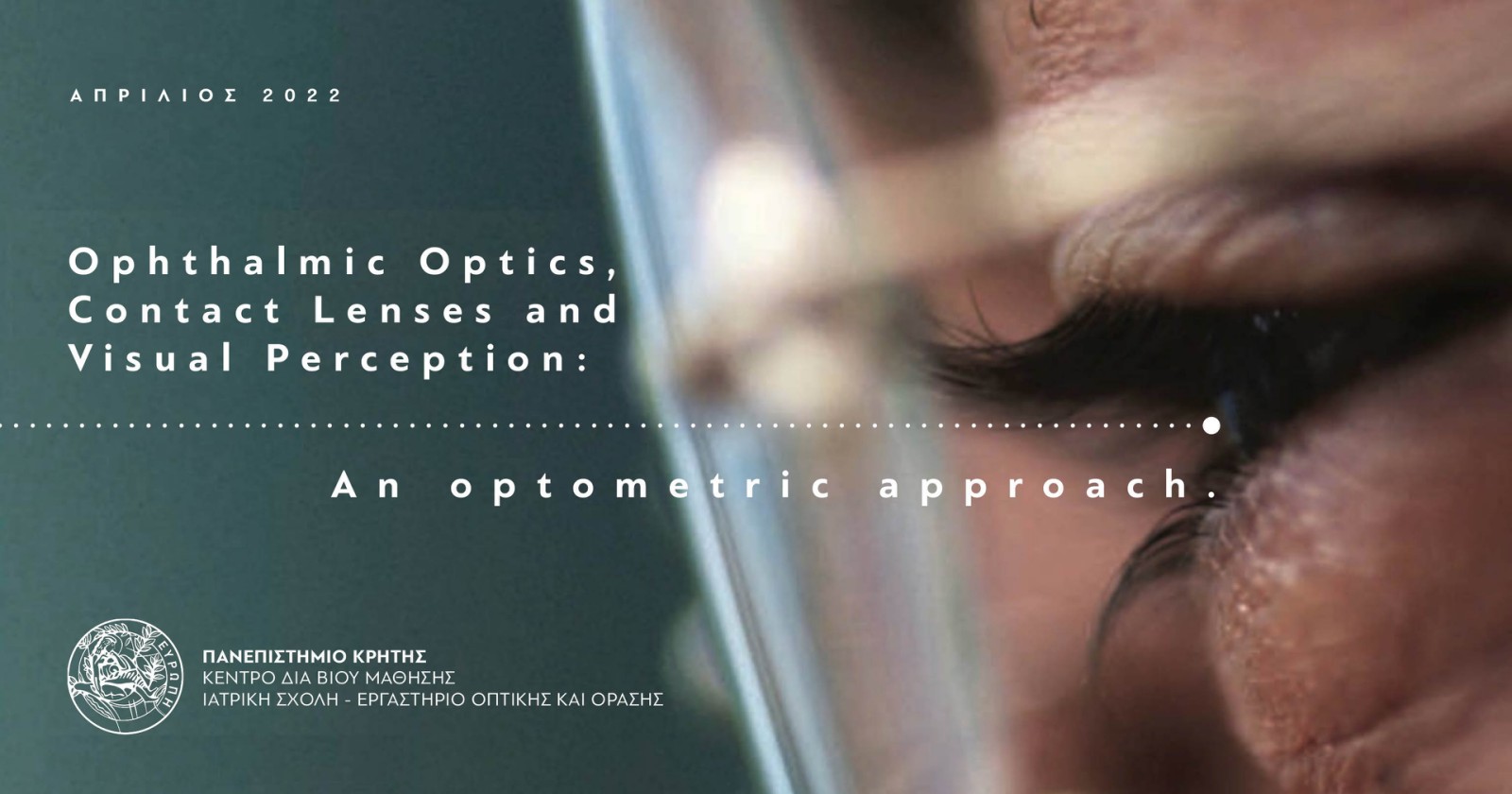Εκπαιδευτικό Πρόγραμμα ΚΕ.ΔΙ.ΒΙ.Μ
"Ophthalmic Optics, Contact Lenses and Visual Perception: an optometric approach"
Εκπαιδευτικό πρόγραμμα (ασύγχρονη εξ’ αποστάσεως εκπαίδευση) από το Κέντρο Επιμόρφωσης και Δια Βίου Μάθησης (ΚΕ.ΔΙ.ΒΙ.Μ) και το Εργαστήριο Οπτικής και Όρασης της Ιατρικής Σχολής του Πανεπιστημίου Κρήτης.

Το επιμορφωτικό πρόγραμμα περιλαμβάνει 25 διαλέξεις στα ελληνικά (50 ώρες παρουσιάσεων - 150 ώρες διδακτική ενασχόληση) με ασύγχρονη εξ’ αποστάσεως εκπαίδευση που εξασφαλίζει "Πιστοποιητικό Επιμόρφωσης" με 6 ECVET από το Κέντρο Επιμόρφωσης και Δια Βίου Μάθησης (ΚΕ.ΔΙ.ΒΙ.Μ) του Πανεπιστημίου Κρήτης.
Επιστημονικός υπεύθυνος: Καθ. Μιλτιάδης Τσιλιμπάρης
Ακαδημαΐκός υπεύθυνος: Δρ. Σωτήρης Πλαΐνης
Διδάσκοντες: Σ. Πλαΐνης, Μ. Τσιλιμπάρης, Ε. Δετοράκης, Σ. Παναγοπούλου, Α. Παλλήκαρης, Γ. Κυμιωνής, Π. Σαπουντζής
Όλες οι μαγνητοσκοπημένες παρουσιάσεις είναι στην ελληνική γλώσσα, και συνοδεύονται από πρόσφατο υποστηρικτικό υλικό από τη διεθνή βιβλιογραφία στα αγγλικά (σχετικά άρθρα, δημοσιεύσεις, κεφάλαια από βιβλία). Η ασύγχρονη παρακολούθηση των 25 μαγνητοσκοπημένων παρουσιάσεων μπορεί να γίνει οποιαδηποτε στιγμή, αρκεί να ολοκληρωθεί μέσα σε διάστημα 3 μηνών από την εγγραφή (η πρόσβαση στα μαθήματα απαιτεί κωδικούς που αποσγτέλλονται μετά την εγγραφή). Μπορείτε να δείτε το πρόγραμμα των παρουσιάσεων ΕΔΩ).
Το κόστος συμμετοχής είναι 500€ - θα σας σταλούν τα απαραίτητα στοιχεία του τραπεζικού λογαριασμού του Πανεπιστημίου με την ολοκλήρωση της εγγραφής σας. Για την αίτηση συμμετοχής επισκεφτείτε το σύνδεσμο εδώ
-Για απορίες σχετικά με την εγγραφή επικοινωνήστε με την κ. Μαρία Παρτάλη στο ΚΕΔΙΒΙΜ (partalim@uoc.gr - 2810393661).
-Για πληροφορίες σχετικά με το εκπαιδευτικό περιεχόμενο επικοινωνήστε με τον ακαδημαϊκό υπεύθυνο Σωτήρη Πλαΐνη (labopticsvision@gmail.com).
__________________________
Course outline
It is evident that the quality of clinical service provided by an eye care practitioner is a function of his/her clinical skills and the provision of state-of-the-art instrumentation facilities and ophthalmic products. The pace of technological and scientific development is much faster today than it was 50 years ago. In the past, when an innovative idea was proposed by a scientist or clinician it was usually followed by a lengthy period of development before any direct application was attempted. This relatively long transitional period allowed widespread discussion of the idea before any practical application was attempted, so that any outcome could be smoothly integrated into clinical practice. In contrast, today’s academic and commercial pressures frequently force premature publication and exploitation of new ideas, methods and therapeutic interventions. Thus, the eye care practitioner, and especially the optometrist, should be equipped with basic knowledge about visual function and functional vision and have full understanding of cutting-edge technology to diagnose, evaluate and manage any refractive condition and decide on the interventions needed to optimise / rehabilitate visual performance.
This course offers a range of basic and advanced knowledge on ophthalmic optics, contact lenses and new technologies for evaluating and correcting visual performance that can bridge the gap between scientific interpretations and patients’ needs, satisfaction and complaints, offering to the eye care practitioner an ongoing search for improved methods of diagnosis and rehabilitation.
_________________
Course presentations
- Human visual perception and natural selection (Plainis)
- Τhe eye as an optical system - Imaging the human eye (E. Detorakis)
- The optical structures and the aberrations of the eyes: from single to human eyes (A. Pallikaris)
- Emmetropisation and myopia progression: a refractive error or a disease? (Plainis)
- Accommodative function: “errors” in focus, fluctuations and dynamics (Plainis)
- Gaze, eye movements and fixation (Plainis)
- Wavelengths, colour perception and colour anomaly (Plainis)
- Binocular vision: summation vs. rivalry (Plainis)
- Phantoms in the visual brain (P. Sapountzis)
- Evaluating visual performance: visual acuity, contrast sensitivity and beyond threshold (Plainis)
- Ageing of the human eye: optics vs. perception (Plainis)
- Presbyopia: why does it come so early in our life? (Plainis)
- Correcting presbyopia: progressive power lenses (Plainis)
- Contact lenses in 2020: where are we heading? (Plainis)
- Optics of contact lenses: what should we know? (Plainis)
- Correcting presbyopia with contact lenses: multifocals vs. monovision (Plainis)
- Myopia management with CLs: orthokeratology vs. multifocal CLs (Plainis)
- Corneal topography: normal vs. irregular cornea (S. Panagopoulou)
- Correcting astigmatism with contact lenses: soft vs RGP (Plainis)
- Surgical correction of refractive error and keratoconus (G. Kymionis)
- Fitting the irregular cornea with contact lenses: corneal vs. semi-scleral vs. scleral (Plainis)
- Correcting presbyopia with surgical techniques (S. Panagopoulou)
- Ocular disease: acquired vs. inherited pathologies (M. Tslimbaris)
- Visual electrodiagnosis in retinal and post-retinal disease (Plainis)
- Low vision patients: how to improve their visual experience (Plainis)
.jpg)





